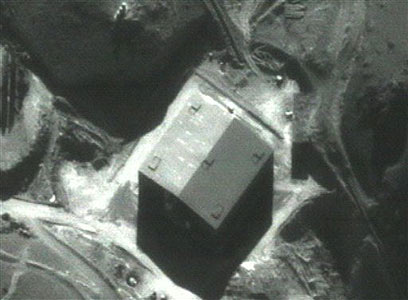
A strike in the desert
German magazine Der Spiegel traces Israel's alleged 2007 strike on Syria's nuke facility
One night in 2007, however, the small village was startled by a huge lightning bolt, followed by a pillar of smoke rising above the waters of a nearby river. Village elders said it was a mystical sign, but according to German magazine Der Spiegel, the incident was far from heavenly.
The morning after the mysterious occurrence saw Syrian news agency SANA report that Israeli fighter jets breached Syrian airspace. "Our air force pushed them back after they dropped munitions above the desert. No injuries or damage were reported."
Israel, however, denied the incident ever happened – a denial both Jerusalem and Damascus reiterate to date. Nevertheless, the world soon learned that fighter jets struck a secret Syrian military facility.
Was it a nuclear plant? How did Israel learn of its existence? And why chance destroying it? Was Israel using the facility to send a warning to Iran?
Der Spiegel set out to investigate the strike, putting together a puzzle that, while less than complete, provides enough information to shed new light on the matter.
Tel Aviv, 2001. Mossad officials are busy profiling newly inducted Syrian President Bashar Assad. Unlike his father Hafez Assad, Bashar is considered unpredictable. The Mossad believes he has an aggressive personality and that he is likely to bolster his hold on Damascus by supplying Hezbollah with weapons.
The intelligence agency also knows of visits by North Korean dignitaries, which focus on delivering advanced weapons to Syria. IDF Intelligence says it is likely that nuclear arms are being discussed, but the Mossad dismisses this theory.
Spring of 2004. US intelligence reports of multiple communications between Syria and North Korea. The calls are traced to a desert location called al-Kibar.
Top IDF Intelligence Unit 8200, tasked with wiretapping and encryption operations, receives the information and the new location is promptly added to its watch list.

The Kibar site (Photo: AP)
December 2006. A top Syrian official, who unbeknown to him was under Mossad surveillance, arrives in London. The man leaves his laptop in his hotel room and the Mossad is able to upload spyware onto the device.
The software soon begins ciphering information, divulging blueprints, correspondence and hundreds of visuals of the Kibar facility in various stages of construction.
One of the photos shows one of North Korea's top nuclear officials meeting with Ibrahim Othman, Syria's atomic energy agency director. The Mossad finally recognizes the imminent danger and alerts then-Prime Minister Ehud Olmert.
February of 2007. Top Iranian General Ali Resa Asgari defects to the US and tells the CIA about Tehran's nuclear developments. Asgari also tells the Central Intelligence Agency that both Iran and North Korea have been funding a secret nuclear project in Syria.
The following month sees Olmert form a three-member panel to report on Damascus' nuclear plans.
Six months later Brigadier General Yaakov Amidror, a member of the trio, tells the prime minister of clear and present danger: Syria, he says, is indeed working with North Korea and Iran on an nuclear facility. Tehran reportedly funneled $1 billion to the project, as Kibar is meant to replace the Iranian reactor if Tehran is unable to complete its uranium enrichment program.
August 2007. IDF intelligence convinces Olmert that Israel must launch an intelligence operation in Syria. Special elite forces are sent beyond the border to sample soil from the Kibar area. They are spotted by the Syrian military and are forced to abort the operation.
Nevertheless, soil analysis reveals traces of nuclear activity in the area.
Olmert informs US National Security Adviser Stephen Hadley of Israel's findings and greenlights an air strike. Operation Orchard is launched.
September 5, 2007. Ten F-15I fighter jets take off from the Ramat David Air Base towards Syria. Three are later called back, leaving seven heading to the Israeli-Syrian border.
The jets fly over the border at low altitude, neutralizing a radar station on their way. They reach their target 18 minutes later. The compound is destroyed with what later footage would reveal as overkill – the bombs used would prove excessive fire power.
Olmert immediately briefs Turkish Prime Minister Recep Tayyip Erdogan of the operation and asks him to relay a message to Assad: Israel will not stand for a Syrian nuclear facility, but will refrain from further military action in the immediate future. Israel, said the communiqué, strives for peace with Syria and will not act unless provoked.
The secret of the desert facility is left for only the sands of Kibar to know.
January 2009. President Assad grants Der Spiegel an interview in which he insists the lost facility was "nothing but a conventional military base." Syria, he tells the magazine, "Could have retaliated, but that would have served Israel's purposes."
But what of the trace uranium found in the soil samples? Israel must have planted that, said Assad. After all, he said, Syria aspires for a nuclear-free Middle East."










